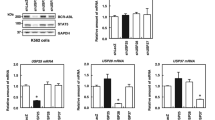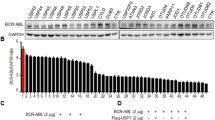Abstract
The development of chronic myeloid leukemia (CML) is the result of a reciprocal translocation between chromosomes 9 and 22 due to the emergence of Philadelphia chromosome. The product of this mutation is a hybrid oncoprotein Bcr-Abl. According to the results of mass spectrometric analysis, USP1 protein was identified as a potential candidate for interaction with the PH domain Bcr-Abl oncoprotein. Due to the deubiquitination properties, USP1 protein can prevent proteasomal degradation of Bcr-Abl oncoprotein in a cell and, consequently, contribute to its accumulation, and the progression of the disease. In this work, creating the genetic constructs, we detected the USP1 protein localization in the cell. Also, a nuclear colocalization of USP1 protein with PH domain of Bcr-Abl oncoprotein in HEK293T cells was shown. The results are important for understanding the implications of the Philadelphia chromosome emergence, and the development of new methods for CML treatment, since the recent techniques are not always effective due to the emergence of numerous mutations that cause drug resistance and relapse of the disease.
Similar content being viewed by others
References
Fausel, C., Targeted chronic myeloid leukemia therapy: seeking a cure, Manag. Care Pharm., 2007, vol. 13, no. 8, pp. 8–12.
Telegeev, G.D., Dybkov, M.V., Dubrovska, A.N., Miroshnichenko, D.A., Tyutyunnykova, A.P., and Maliuta, S.S., Development of molecular oncohematology in Ukraine, Biopolym. Cell, 2013, vol. 29, no. 4, pp. 277–282.
Zhao, X., Ghaffari, S., Lodish, H., Malashkevich, V.N., and Kim, P.S., Structure of the Bcr-Abl oncoprotein oligomerization domain, Nat. Struct. Biol., 2002, vol. 9, no. 2, pp. 117–120.
Järas, M., Johnels, P., Agerstam, H., Lassen, C., Rissler, M., Edén, P., Cammenga, J., Olofsson, T., Bjerrum, O.W., Richter, J., Fan, X., and Fioretos, T., Expression of P190 and P210 BCR/ABL1 in normal human CD34(+) cells induces similar gene expression profiles and results in a STAT5-dependent expansion of the erythroid lineage, Exp. Hematol., 2009, vol. 37, no. 3, pp. 367–375.
Colicelli, J., ABL tyrosine kinases: evolution of function, regulation, and specificity, Sci. Signal., 2010, vol. 3, no. 139, re6.
Telegeev, G.D., Dubrovska, A.N., Dybkov, M.V., and Maliuta, S.S., Influence of BCR-ABL fusion proteins on the course of Ph leukemias, Acta Biochim. Pol., 2004, vol. 51, no. 3, pp. 845–849.
Telegeev, G.D., Dubrovska, A.N., Nadgorna, V.A., Dybkov M.V., Zavelevich, M.P., Maliuta, S.S., and Gluzman, D.F., Immunocytochemical study of Bcr and Bcr-Abl localization in K562 cells, Exp. Oncol., 2010, vol. 32, no. 2, pp. 81–83.
Miroshnychenko, D., Dubrovska, A., Maliuta, S., Telegeev, G., and Aspenström, P., Novel role of pleckstrin homology domain of the Bcr-Abl protein: analysis of protein–protein and protein–lipid interactions, Exp. Cell Res., 2010, vol. 316, no. 4, pp. 530–542.
Cotto-Rios, X.M., Jones, M.J., and Huang, T.T., Insights into phosphorylation-dependent mechanisms regulating USP1 protein stability during the cell cycle, Cell Cycle, 2011, vol. 10, no. 23, pp. 4009–4016.
Wilkinson, K.D., Ubiquitination and deubiquitination: targeting of proteins for degradation by the proteasome, Semin. Cell Dev. Biol., 2000, vol. 11, no. 3, pp. 141–148.
Reyes-Turcu, F.E., Ventii, K.H., and Wilkinson, K.D., Regulation and cellular roles of ubiquitin-specific deubiquitinating enzymes, Annu. Rev. Biochem., 2009, no. 78, pp. 363–397.
Jadhav, T. and Wooten, M., Defining an embedded code for protein ubiquitination, J. Proteom. Bioinform., 2009, vol. 2, pp. 316–333.
Nijman, S.M., Luna-Vargas, M.P., Velds, A., Brummelkamp, T.R., Dirac, A.M., Sixma, T.K., and Bernards, R., A genomic and functional inventory of deubiquitinating enzymes, Cell, 2005, vol. 123, no. 5, pp. 773–786.
Nijman, S.M.B., Huang, T.T., Diras, A.M., Brummelkamp, T.R., Kerkhoven, R.M., D’Andrea, A.D., and Bernards, R., The deubiquitinating enzyme USP1 regulates the Fanconi anemia pathway, Mol. Cell, 2005, vol. 17, no. 3, pp. 331–339.
Cotto-Rios, X.M., Jones, M.J., Busino, L., Pagano, M., and Huang, T.T., APC/CCdh1-dependent proteolysis of USP1 regulates the response to UV-mediated DNA damage, J. Cell Biol., 2011, vol. 194, no. 2, pp. 177–186.
Liang, Q., Dexheimer, T.S., Zhang, P., Rosenthal, A.S., Villamil, M.A., You, C., Zhang, Q., Chen, J., Ott, C.A., Sun, H., Luci, D.K., Yuan, B., Simeonov, A., Jadhav, A., Xiao, H., Wang, Y., Maloney, D.J., and Zhuang, Z., A selective USP1-UAF1 inhibitor links deubiquitination to DNA damage responses, Nat. Chem. Biol., 2014, vol. 10, no. 4, pp. 298–304.
Williams, S.A., Maecker, H.L., French, D.M., Liu, J., Gregg, A., Silverstein, L.B., Cao, T.C., Carano, R.A., and Dixit, V.M., USP1 deubiquitinates ID proteins to preserve a mesenchymal stem cell program in osteocarcoma, Cell, 2011, vol. 146, no. 6, pp. 918–930.
Kumar, A., Agarwal, S., Heyman, J.A., Matson, S., Heidtman, M., Piccirillo, S., Umansky, L., Drawid, A., Jansen, R., Liu, Y., Cheung, K.H., Miller, P., Gerstein, M., Roeder, G.S., and Shyder, M., Subcellular localization of the yeast proteome, Genes Dev., 2002, vol. 16, no. 6, pp. 707–719.
Fraile, J.M., Quesada, V., Rodriguez, D., Freije, J.M., and Lopez-Otin, C., Deubiquitinases in cancer: new functions and therapeutic options, Oncogene, 2012, vol. 31, no. 19, pp. 2373–2388.
Rual, J.F., Venkatesan, K., Hao, T., Hirozane-Kishikawa, T., Dricot, A., Li, N., Berriz, G.F., Gibbons, F.D., Dreze, M., Ayivi-Guedehoussou, N., Klitgord, N., Simon, C., Boxem, M., Milstein, S., Rosenberg, J., Goldberg, D.S., Zhang, L.V., Wong, S.L., Franklin, G., Li, S., Albala, J.S., Lim, J., Fraughton, C., Llamosas, E., Cevik, S., Bex, C., Lamesch, P., Sikorski, R.S., Vandenhaute, J., Zoghbi, H.Y., Smolyar, A., Bosak, S., Sequerra, R., Doucete-Stamm, L., Cusick, M.E., Hill, D.E., Roth, F.P., and Vidal, M., Towards a proteome- scale map of the human protein0protein interaction network, Nature, 2005, vol. 437, no. 7062, pp. 1173–1178.
Chin, C.J., Wong, S., Davis, M.J., and Ragan, M.A., Protein-protein interaction as a predictor of subcellular location, BMC Syst. Biol., 2009, no. 3, pp. 28–31.
Jiang, J.Q. and Maoying, W., Predicting multiplex subcellular localization of proteins using protein-protein interaction network: a comparative study, BMC Bioinform., 2012, no. 13, pp. 10–20.
Dunn, K.W., Kamocka, M.M., and McDonald, J.H., A practical guide to evaluating colocalization in biological microscopy, Am. J. Cell Physiol., 2011, vol. 300, no. 4, pp. 723–743.
Zinchuk, V., Zinchuk, O., and Okada, T., Quantitative colocalization analysis of multicolor confocal immunofluorescence microscopy images: Pushing pixels to explore biological phenomena, Acta Histochem. Cytochem., 2007, vol. 49, no. 4, pp. 101–111.
McDonald, J.H. and Dunn, K.W., Statistical tests for measures of colocalization in biological microscopy, J. Microsc., 2013, vo. 252, no. 3, pp. 295–302.
Carcia-Santisteban, I., Zorroza, K., and Rodriguez, J.A., Two nuclear localization signals in USP1 mediate nuclear import of the USP1/UAF1 complex, PloS One, 2012, vol. 7, no. 6, e3870.
Author information
Authors and Affiliations
Corresponding author
Additional information
The article is published in the original.
About this article
Cite this article
Antonenko, S.V., Gurianov, D.S. & Telegeev, G.D. Colocalization of USP1 and РН domain of Bcr-Abl oncoprotein in terms of chronic myeloid leukemia cell rearrangements. Cytol. Genet. 50, 352–356 (2016). https://doi.org/10.3103/S0095452716050029
Received:
Published:
Issue Date:
DOI: https://doi.org/10.3103/S0095452716050029




